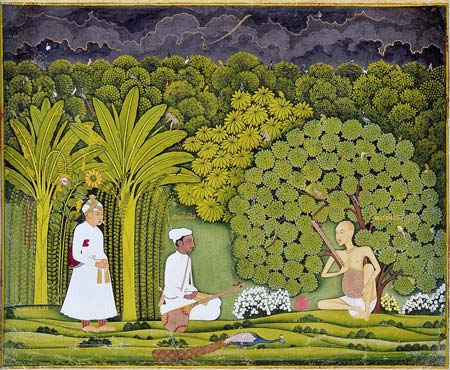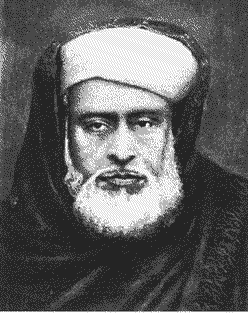About dhrupad

The word dhrupad/dhruvapada is derived from the literal conjunction of the terms – dhruva and pada: dhruva is an essential part of the poem, which acts as the refrain of the song-text, while pada means text of the song – the philosophy and the message of the poet-composer. The texts of dhrupad include philosophy, mythology, nature, and various aspects of life and music. They are mostly written in Braj language. Dhupad compositions sang up to the present day bear testimony to the immense treasure of this medieval literature.
Experiencing extempore musical thoughts adorned with the prescribed fineness is the distinctive characteristic of dhrupad. The tanpura is an essential drone instrument to accompany this music. A dhrupad performance begins with an improvised exposition of the raga (melodic pattern) called alap. Alap is sang with syllables without definite meaning, whose vocal rendering creates the impression of a song. Exposition of the raga is developed with sophisticated ornamentations of the tones, including slow glissading movements, momentary pitch inflections, microtonal variations and intonations.
Alap is divided into three parts: slow alap, followed by madhya-alap or jod set to medium tempo and drut-alap or jhala set to fast tempo. The long held notes of the first part of alap permit the experience of dwelling in each interval to create tonic shades. In this process, artists are allowed to experience unlimited possibilities of melodic combinations. The melody is gradually unfolded, with tonic phrases moving down to the lower register and then progressing towards the middle and upper registers, adorned with subtle tonal embellishments, characterizing the raga. The introduction of pulse by the performer is continued in the progression of madhya-alap and drut-alap with different rhythmic patterns.
The concept of alap, madhya-alap and drut-alap is primarily based on the fineness that transcends one’s self to a highly meditative state of mind. Sonic experience of dhrupad is essentially based on the audible and inaudible sound that carries the mood of the raga with the help of right intonation, tonic shades with appropriate melodic movement, delivering the melodic phrases with instant and extempore inspiration from that particular moment of practice.
After alap, song text with a prefixed composition is presented with the accompaniment of a percussion instrument, the pakhawaj. Performers cherish this part of rendition with improvisations, embellished with numerous rhythmic variations called upaj. Musicians add beauty to the form of rendition by manipulating the words of the poem to create intricate subdivisions (layakari). Pakhawaj players follow and balance these variations with their own patterns of improvisation to make it livelier.
Dhrupad embodies a distinguished manifestation of swara (notes), tala (rhythm) and pada (poem). The transitions from the state of alap with its slow glissading movements to the most exciting and energetic presentation of the composition sublimate this rendition style, adorned with aesthetic qualities. Discipline of time keeping (tempo — laya), rhythmic cycle, rhythmic variations, and poetic concepts are the distinctive features of dhrupad. This musical genre encompasses diverse aesthetical values and poetic contents that pave the way for artistic manifestation augmented by the melodic and poetic thoughts. Dhrupad is a blending of the delicate (subtle) and strong (explicit) nuances of rendition, which generates a unique experience. It is a comprehensive form of music, which carries all the essential qualities of a vocal and instrumental recital. It is a powerful medium for the delineation of rasa (aesthetics).
The Dagar tradition

Alap plays a very important role in the melodic improvisation of the Dagar-vani. This tradition has a very intricate and complex system of rhythmic improvisation, in conformity with the mood of melody and song-text. The whole process of alap in the Dagar tradition is like a meditation, immerging into the mood of the melody through extempore manifestation of creativity. In course of alap, endless myriad total patterns are created by the application of intonation and variable micro-tones. The emphasis is on developing each note with purity and clarity. To quote Ustad Zia Fariduddin Dagar:
“Alap entails the search to get the most perfect pitch of every note. It takes you into a sort of meditation in which you are lost in the waves of sound and forget everything. There remains only sound.”
Voice culture is an essential discipline of this tradition with the first course of practice starting pre-dawn and usually finishing before sunrise. Prescribed methods and courses are followed at different times of the day for efficient voice training. In the Dagar tradition, singing and playing both are practiced with equal importance, voice and the rudraveena (a lute instrument), complement each other. According to the principles of the Dagar tradition, voice is considered to be a sort of veena and is termed gatra-veena. Right intonation, application of micro-tones appropriated for the melodic mood is another significant feature of the Dagar-vani.
Jugalbandi
Jugalbandi is a musical experience in Indian classical music that features a pair of solo musicians playing music of the same genre. The word jugalbandi means literally “entwined twins”. Unlike a solo musical performance, this duet musical experience can be described as a process of exchanging energy between the participating musicians, which augments the artistic creation of two different persons for a common melody and mode. The encounter between two soloists in such an event becomes a magnificent musical experience for ardent connoisseurs, as they get to observe and listen to the musical dialogue between the musicians.
Duet musical experience in dhrupad tradition can be traced back to the 19th century. There were several duos, who shared their musical experiences through the ages and established themselves as accomplished duo performers with various combinations of instrumentalists and vocal musicians. Ustad Allahbande Khan and Ustad Zakiruddin Khan Dagar, Ustad Nasir Moinuddin Khan Dagar and Ustad Nasir Aminuddin Khan Dagar, Ustad Nasir Zahiruddin Khan Dagar and Ustad Nasir Faiyazuddin Khan Dagar are a few to mention among the popular vocal duos in the Dagar tradition. The duet musical experience of Ustad Zia Mohiuddin Dagar and Ustad Zia Fariduddin Dagar established an example of jugalbandi of the rudraveena (a lute instrument) and vocal rendition, which had been widely appreciated and cherished by the audience in India and abroad as a unique combination of a vocal and instrumental art.
